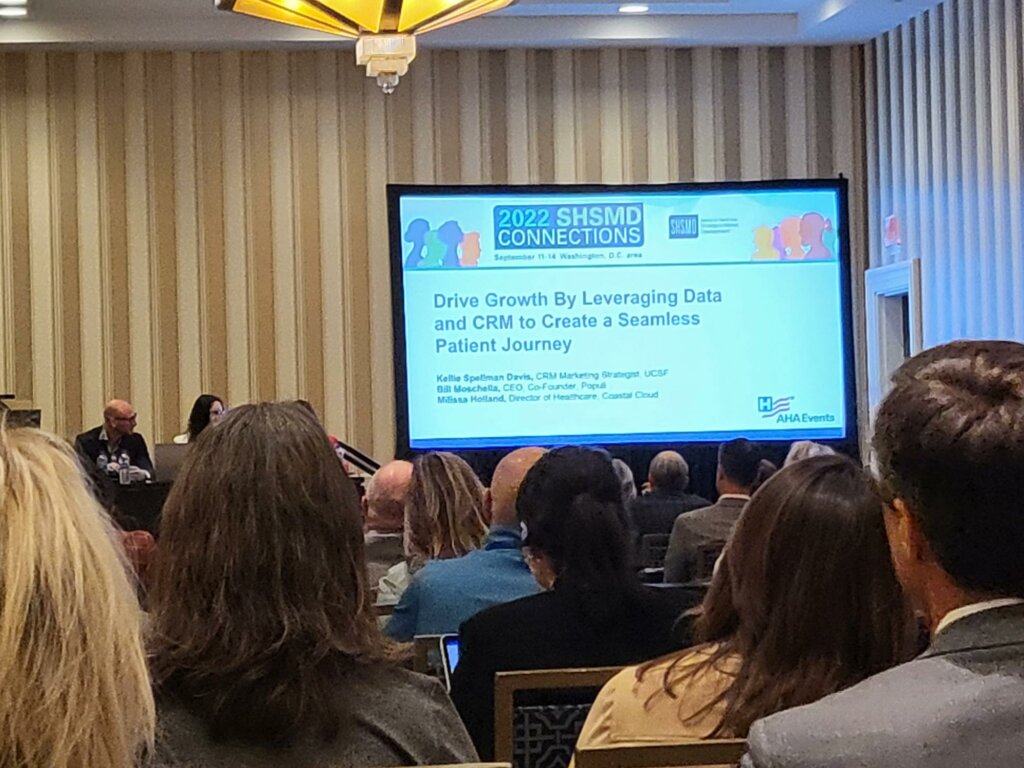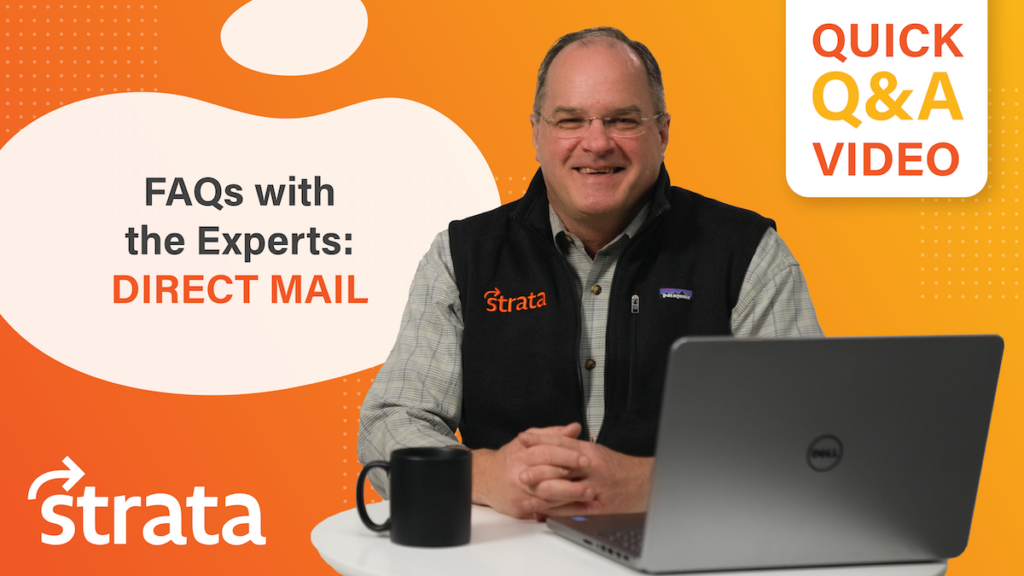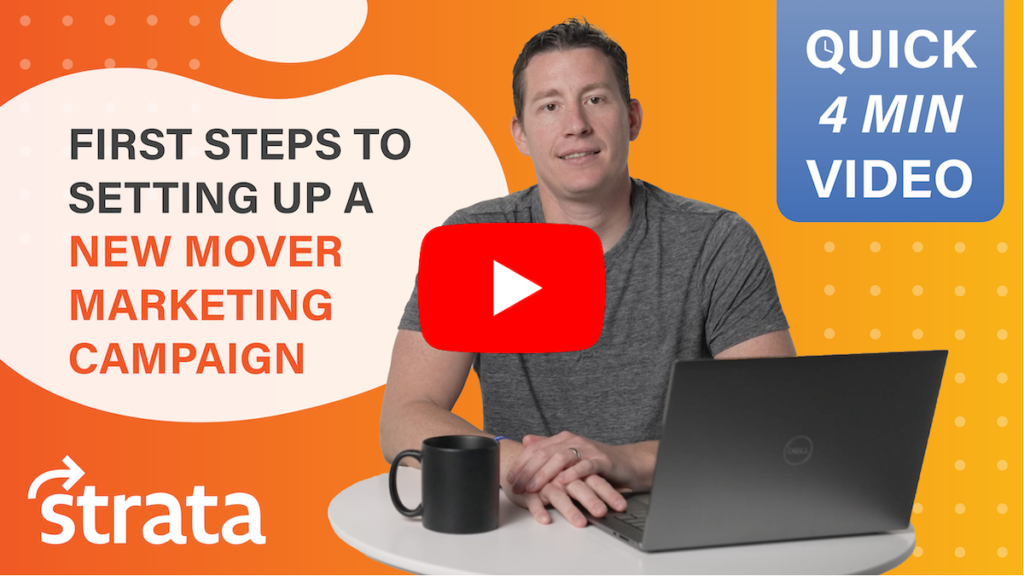A Strata YouTube Original Series
In today’s marketing world, if you’re not using variable printing on your print marketing materials, you may be falling behind. Why? Variable printing can completely transform your marketing campaigns and increase their effectiveness. With even the simple addition of a name to your direct mail, response rates can increase by 135%, and purchases can increase by 62%[CP1] !
If you’re new to variable printing, want to know more about it, or even if you’re somewhat experienced in it, it may be a good idea to follow along as our Data Graphic Specialist, Bryan Mathes, answers several frequently asked variable printing questions. We’ve written out some of his interview answers below, and the full interview can be found here.
Q: What is variable printing?
A: Variable Data Printing is printing that uses data to create personalized or unique print and mail pieces. Some common examples of variable data are things like names, addresses, monetary amounts, images, QR Codes, and other kinds of data that could be made specific to a person or product.
Q: Why is variable printing so important in today’s marketing world?
A: People really like to feel seen, heard, and special. They don’t want to feel like just another face in the crowd or one more number that may or may not make a purchase. Personalized print and mail pieces have much greater impact on the recipient than generic ones.
Q: What are the main benefits of variable printing?
A: Most obviously, variable printing gives you personalization down to the recipient level. Every printed piece can be totally different from the next one depending on your variables and what they control.
As we said above, Bryan answers these questions in more depth throughout the full interview, and he also covers the following the questions:
- When should I use variable printing versus regular/generalized print practices?
- What do I need to get started with variable printing?
- What are the most common variables used/changed in variable printing?
- How much, on average, does variable printing improve response rates?
- Are special/specific printers needed for variable printing?
- What is important to keep in mind when creating variable data files?
- What are some signs of a good variable printing partner?
View the full interview by clicking the image below. And, feel free to explore our blog and YouTube channel for more information and printing tips!
If you’d like to connect with our experts or have additional questions, contact us today! Our team would be happy to help you make smart happen.
A Strata YouTube Original Series
In a highly digital world, direct mail remains a powerful way to connect with your audience. In fact, print is a great way to keep your customers connected by breaking up your digital campaigns with the physical! In Strata’s latest YouTube video, we sit down with Rob Krischker, one of Strata’s Strategic Sales Representatives, as he answers several frequently asked questions surrounding direct mail marketing and talks through how it can enhance your future marketing campaigns. See below for a snippet of the full YouTube video…
Does direct mail still work?
The short answer is…yes, of course it does! The biggest reason is because it always has and still delivers a measurable return on investment.
When is the best time to send direct mail?
Some things to consider are your goals, busy seasons (for you, your competitors, and others sending mail), and any time sensitivity surrounding your mail.
How do I decide on a direct mail size & fold?
This also heavily depends on your goals. But, at the very least, I’d recommend a size, fold, and dimension that stands out from a #10 envelope (which is the size and format of most of your mail).
In the full interview, Rob answers the questions above in more depth, and covers the following questions:
- Who should I be sending my direct mail to?
- What’s the difference between direct mail and junk mail?
- What’s a key part of direct mail that’s becoming more important each year?
- Why would I choose direct mail over just email, digital ads, or other digital tools, and what’s the value of including direct mail in my multiple touch points?
You can view the full interview by clicking the image below. Also, feel free to explore our blog for other direct mail tips and stats!
If you’ve got any additional questions or want to connect with our experts, contact us today and we’ll help you make smart happen.
How to Understand & Improve Your Print Mail Campaigns
We’ve said it before – direct mail is a powerful tool. Whether you’re trying to connect with Gen Z or Baby Boomers, almost anyone and everyone can be persuaded by its effectiveness, if well-executed. So, how do you determine if your direct mail campaign is working? Let’s discuss some measurements of direct mail success…
Response Rate
Direct mail response rate is, simply stated, the percentage of people who respond to physical mail pieces (which could be postcards, letters, flyers, dimensional mail, and so on). Responses could come from things like website visits through QR codes or URLs, business reply cards (BRCs), or even coupon code uses and coupon scans. Response rate can help determine which part(s) of your direct mail marketing campaign are working, and what areas need improvement.
To calculate the direct mail’s response rate, use the formula:
Response Rate = (Responses / Mail Pieces) x 100
Let’s look at an example of equating response rate. Let’s say you send out 1,000 pieces of mail advertising the grand opening of your new grocery store, and you receive 30 responses. You’d determine your response rate using the following formula:
(30 responses / 1000 pieces of mail) x 100 = 3%
Keep in mind, the average response rate of direct mail falls between 2.7% and 4.4%, so don’t be deterred by seemingly “low” numbers. To best ensure you’ll be able to calculate and understand response rates, make sure each direct mail piece has a clear call-to-action (CTA). Whether that’s a special offer, coupon, or link to a landing page, it’s important to include identifiable URLs that you can easily track – like UTMs, PURLs, or specified QR codes. Or, make sure they can easily respond via a business reply card. This ensures that, even if the recipient doesn’t take full action, you’re aware of whether they made action at all, if you sparked their interest, and if you’ll possibly remain on their radar.
The call to action (CTA) is the driving force behind a successful landing page. It propels users to act, with phrasing such as “don’t miss out”, “learn more”, “click here”, and so on. Landing pages should be designed with a single, concise call to action. Too many calls to action can create confusion, so again – stick to just one powerful, action-oriented verb that leaves no room for ambiguity. What you want the user to do should be simple and clear.
Return on Investment (ROI)
To calculate the direct mail’s return on investment, use the formula:
ROI = (Net Income / Expense) x 100
Let’s say, for example, you spend $5,000 on postcards. You find that the mailing brings in $15,000 in revenue. If you subtract the initial cost of $5,000 from the revenue of $15,000, you’ve made $10,000 in revenue. To calculate ROI in this instance, the equation would be:
($10,000 / $5,000) x 100 = 200%
So, you’d have an ROI of 200%!
And, if you’re looking to get some help calculating ROI, you can plug the above information into USPS’s ROI Calculator.
Conversion Rate
With the inclusion of CTAs in your direct mail pieces, you’ll be able to track conversion rate. Conversions are often purchases – but that’s not always the case. Sometimes, conversions are things like rewards program signups, app downloads, or referral requests. Either way, to determine your conversion rate, look at the number of people who responded to your mail in comparison to those who became customers (or signed up/downloaded the app/requested a referral).
To calculate the direct mail’s conversion rate, use the formula:
Conversion Rate = (Conversions / Responses) x 100
For example, let’s say 30 people responded to your postcard, and out of those 30, 6 people downloaded your company’s mobile app (the conversion in this case).
(6 downloads / 30 responses) x 100 = 20%
Your conversion rate comes to 20%. Plus, you now know which customers to continue to build relationships with and can (likely) turn them into returning customers.
Monetary Return
To determine the monetary return of each of your touchpoints, you’ll need the following information: sale price, number of mailings, response rate, and conversion rate. As noted above, response rate measures the number of recipients who responded to the direct mail piece, while conversion rate takes the percentage of people who converted.
Ways to Increase Campaign Effectiveness
Now that you can calculate your direct mail’s success, how do you increase it? We have a few recommendations to ensure you’re creating and sending ROI rich direct mail.
Tracking & Attribution
Understanding the health of your direct mail campaigns is easier with first-person information. As stated above, when designing your mail pieces, be sure to include QR codes, PURLs, a phone number, or another easy-to-follow CTA. Not only are you establishing trust between the recipient and your brand (by giving them the power to respond on their accord), you’ll also be able to track which recipients (and how many) are responding.
Design Compelling Pieces
It’s no secret that people love good design. It’s important to keep that in mind when crafting your direct mail. Keep your messaging short, sweet, and to the point, while creating a sense of urgency – don’t overflow the piece with too much content. If a piece would look and possibly perform better on a postcard than in a letter format, think through various shapes, sizes, and textures. Most importantly, use market research or previous data (if you have it) to understand and use what your customers best respond to.
Know Your Audience
Understanding the geographics, demographics, as well as psychographic behaviors of your target demographic is imperative to the details of your campaigns. The more information you have on your customers, the better you can reach and speak to them.
For example, let’s again say you’re conducting a grocery store grand-opening campaign. You’re aware your new neighbors are primarily millennials. So, you send postcards announcing the grand opening and include a redeemable coupon (that can be used online via QR code or in-store via postcard scan). Additionally, you include photography that best matches the demographic background of your target recipients. You’ve provided these highly tech-savvy millennials with two ways to access the deal, while still encouraging them, and those less inclined to visit online, to come into the store.
Looking Ahead…
Direct mail continues to provide valuable customer and marketing insights and can be a key player in your multi- and omnichannel campaigns. Even as the digital landscape continues to evolve, heavily due to privacy policies and laws, mail proves to be an effective outlier. And, it’s even more successful if it’s done well. If you’re looking to get started with direct mail, want to discuss the measurements above, or just want to talk more about marketing campaign options and tactics, connect with Strata’s experts today.
A Strata YouTube Channel Original
In our last few blogs (and their corresponding YouTube videos) we’ve gone over the basics of new mover marketing, how to choose the right partner, and some steps to get started. Now, it’s time to take a deeper dive into how you can specifically utilize new mover marketing in the grocery industry and what channels and workflows work best.
A Quick Review of New Mover Marketing
To give you a brief refresher, new mover marketing is a specific, niche marketing tactic that’s designed to reach new residents in your area. It’s one of the most effective ways to bring in new customers that have just recently entered your specific target market. When it comes to new movers, they’re nobody’s customer, yet – so it’s an effective tactic to make a good first impression at the same time they’re looking for your product or service.
What do New Residents Really Want?
To answer the question, new residents are looking for “reliables”. These are goods and/or services that new movers can depend on daily, weekly, monthly, or even yearly. Since they’re new to the area, they’re usually unsure where to start. When it comes to grocery stores, sometimes there can be almost too many options for consumers to choose from. Because of this, you, as a grocery store, are in constant competition with other stores near you. That’s why it’s so important for your grocery store to be the first to reach out and make the consumer aware of your store – before competitors – and show them you’re close by. With immediate outreach, they’ll see you care, are convenient, and have quality goods.
The Best New Mover Channels for Grocers
We’ve deemed ourselves experts in new mover marketing all around – and we’re very practiced in some of the best channels and workflows for grocers (specifically) to reach new movers. One of the best channels you can take advantage of is direct mail. We know direct mail to be vital to the success of new mover campaigns, especially those of grocery stores. When mail is executed correctly, with personalization and attribution tactics, it can cut through all the digital noise and stand out in the mailbox. As we’ve mentioned in past blogs and videos, the average response rate for direct mail can be up to 50% more effective than those of email blasts, so it’s definitely worth your time and money!
Like we hinted at above, not all direct mail is created equal, so we suggest that those in the grocer industry send a “welcome handshake”. This is either a 6×9 or 6×10 postcard or bifold that allows your store to be introduced and represented in the best way possible. Again, the key to a good direct mail campaign is making sure it’s personable and actionable. With personalization and calls-to-action, you can welcome new movers to the neighborhood by first name and provide a personalized offer, which they can access by QR code or PURL. Another option? Provide a personalized coupon that they can redeem in-store, upon their first visit. If you want to go a step further in terms of personalization, include a map that shows the location of your store relative to their new residence. Generally, you want to make it as easy and enticing as possible for new movers to choose and visit your store.
What’s Next?
With this quick read, you now have a look into one of the top grocery industry channels to utilize for your next new mover campaign. But – it doesn’t stop there! We still have more suggestions when it comes to the best channels and workflows for grocery establishments like yours. Head over to our YouTube channel, where you’ll hear these suggestions from Connor, a member of Strata’s Strategic Sales Team. Or, if you’re ready to take these new mover marketing steps with Strata, contact us today.
A Strata YouTube Channel Original
In our last three blogs (and their corresponding YouTube videos) we’ve gone over the basics of new mover marketing. It’s important to remember that new mover marketing can differentiate between industries, so the best plan of action for specific business types may not be the same as others. In this blog and its corresponding YouTube video, we’re taking a deep dive into how you can specifically utilize new mover marketing in the healthcare sector – as well as what channels work best.
A Quick Refresher on New Mover Marketing
To give you a brief refresher, new mover marketing is a specific, niche marketing tactic that’s designed to reach new residents in your area. It’s one of the most effective ways to bring in new customers that have just recently entered your specific target market. When it comes to new movers, they’re nobody’s customer, yet – so it’s an effective tactic to make a good first impression at the same time they’re looking for your product or service.
What are New Residents Actually Looking For?
To answer the question, new residents are on the lookout for “reliables”, which are goods and services they can depend on daily, weekly, monthly, or even yearly. The healthcare industry is full of these “reliable” services – and these services are much different than those of grocery stores and restaurants. Customers will more likely choose any grocery store or restaurant to at least check out and maybe turn into their new “go-to” spot. If it ends up that they don’t like the spot – it’s really no big deal. They’ll move on and find another. With healthcare, most people don’t want to “try out” 4 or 5 doctors/healthcare services until they find one they like. In general, it’s a lot more work to fill out paperwork and questionnaires at healthcare offices, and most people only want to do that once.
Potential patients want to feel important and valued, so it’s key to be the first to reach out. When you reach out – first, the potential patient can get to know you and your system, while ensuring that you’ll be there in their times of need.
Best New Mover Healthcare Campaign Channels
Based on our years of expertise and data collection, we’ve compiled a list of what we think are the best channels to utilize when reaching out to new movers to hopefully turn them into patients. The first channel we recommend utilizing is direct mail. The average response rate for direct mail can be up to 50% more effective than that of an email blast, when done correctly. For a direct mail campaign to be done correctly, there must be some aspect of personalization, multiple response vehicles (such as QR codes and PURLs) and accurate data lists. The key to quality, effective direct mail is incorporating more than one touchpoint. If you’re able to send more than one direct mail piece, your potential patient will be consistently reminded of you and your business.
The next channel we recommend utilizing? Digital advertising. Targeted, focused ads can show potential patients that you’re close by and welcoming new patients. A benefit to using digital advertising? The level of precision. With digital ads, you can measure performance through impressions served and ad clicks. If you pair with the right new mover marketing partner for your business, you’ll be able to see how many and which customers converted due to your digital ads. This real-time data is vital to the success of your campaigns. It allows you to see what campaigns are working, which ones are not, and make the necessary adjustments on the fly rather than once the campaign is over.
What’s Next?
You now have some potential, optimal channels to utilize as a part of your next new mover campaign. But it doesn’t stop there! We still have more suggestions. Head over to our YouTube channel (by clicking the thumbnail below) to hear from Rob, a member of Strata’s Strategic Sales Team. He’ll fill you in on the rest of our channel recommendations. If your healthcare system is ready to take these new mover marketing steps with the team at Strata, contact us today.
Key Takeaways from SHSMD Connections 2022
Back at it Again!
It was great to see everyone at SHSMD 2022 in National Harbor, MD! With our new, brightly lit and eye-catching booth backdrop, we were able to meet new contacts – as well as catch up with current clients! The light and inviting atmosphere of our booth made it a great space to discuss marketing goals and showcase some of what we do here at Strata.
With SHSMD 2022 wrapped up, we’re excited to see how our connections grow, and how we can continue to help healthcare marketers and others with offerings beyond just new mover marketing. Whether it’s patient acquisition, talent acquisition, or promoting your service lines – we’re here to take your marketing to the next level. With that said, here are a few of our key takeaways in case you missed the show or didn’t get to stop by our booth this year.

The Conference in Review
At the beginning of the show, the team first joined other SHSMD attendees at Monday morning’s keynote — delivered by Suneel Gupta, a bestselling author, host of an American Express docuseries and podcast, and Visiting Scholar at Harvard Medical School. He spoke on the importance of long-term successes coming from short-term embarrassment, and explained that by gathering people who will challenge, encourage, work alongside and coach you, you’re becoming “backable.” He also emphasized that putting yourself out there only helps you get better at what you do – and that it’s important to be “backed” by the team you’ve assembled.

From there, the team moved to breakout rooms to learn a bit more about the needs and challenges that healthcare marketers currently face. We attended sessions surrounding digital and AI learning, nursing acquisition and retention, media buying innovations, and more.
A big topic was the idea that – as we’re continuing to traverse the digital age, it’s important that healthcare providers meet their potential patients and talent where they are. Whether someone is looking for an urgent care center, a primary care provider, or employment, the goal is to remain end-user focused. When marketing healthcare services to people in your area, it’s vital (no pun intended) to utilize demographic and psychographic data for the targeted population that your healthcare center serves. Because of this idea and the rise of ethical marketing, we’re seeing just how tactful marketing campaigns – both print and digital – need to be in order to be successful and worthwhile. Strata is well versed in this notion, and the atmosphere and chatter at SHSMD 2022 simply reiterated and expanded upon what we know to be true. Whether you need marketing that will facilitate patient acquisition, talent acquisition, or service line promotion, we’re here to make smart happen. We can help streamline your marketing to reach the talent you need and the customers you want. Right where they are.


Some Final Thoughts
Last but not least – the conference reinforced the importance of good design to reach and engage your target audience! We’re glad that, here at Strata, personalized, eye-catching campaigns are right up our alley – and we have the experience and design talent to make them happen. Using demographic and psychographic data, as well as eye-catching imagery and layout, we create compelling pieces of print, direct and digital mail that follow branding specific to our clients and incorporate unique touches that help your system stand out among competitors.

Didn’t get to discuss your healthcare needs with us at SHSMD 2022? No worries. We’re happy to have a quick chat or set up a call. Contact us today!
A Strata YouTube Channel Original
In our past two blogs and their connected YouTube videos, we’ve given you a ton of basic information on new mover marketing. Now, it’s time to get into the first steps of starting a new mover marketing campaign. If you’re not super familiar with new mover marketing, it can be difficult to determine where and how to start, but we’ll lead you through the first things to do and ensure you’re well prepared.
A Quick Refresher on New Mover Marketing
To give a brief refresher, new mover marketing is a specific, niche marketing tactic that’s designed to reach new residents in your area. It’s one of the most effective ways to bring in new customers that have just recently entered your specific target market. When it comes to new movers, they’re nobody’s customer, yet- so you must make a good impression at the same time they’re looking for your product or service.
First, Answer the Question – Is a New Mover Campaign Right for Your Company?
New mover marketing is continually gaining popularity, and fast. It’s currently up 3% since last year, despite any economic rough patches. Why? Because people are always moving. Whether it’s for a new job, family changes, the need to start fresh, or anything else – and that will never change. When someone moves to a new area, they’re almost solely focused on unpacking, organizing, and settling in. They’ll heavily rely on word of mouth (WOM) marketing and other advertising to learn and figure out all their new go-to spots.
However, all this doesn’t mean that new mover marketing is fit for every business. It’s important to realize how (and if) your business can benefit from new mover marketing, and when another type of campaign would make more sense. At Strata, we typically say that if your product or service is needed within the first 6 months of a move, you should be targeting new movers. Anything within that 6-month mark would be something that new movers need in their day-to-day lives after a move. For example, think grocery stores, dentists, vets, salons – the list is endless. On the flip side, anything after that 6-month mark will typically be something they already own/have and are looking to buy new, now that they’re settled in. A good example of this? A new car. The majority of people don’t move to a new town and automatically search for and buy a new car. New mover marketing is all about the new movers’ priorities, so it’s important to understand where your business falls within those priorities.
Start with the Right Data
The use of data is incredibly important for new mover marketing, but it’s even more important to target the right people rather than all the people. You want your efforts to pay off – so sending new mover campaigns to residents who’ve already been established for years or have moved within the same zip code will more than likely be a waste of your time (and money). Sometimes, a smaller list will produce higher ROI, since you’re targeting actual, definite, new movers. Make sure you work with a reliable and well-versed company to ensure quality data over quantity of data. To learn more about the importance of quality over quantity, check out this blog.
What’s Next
Now you have the first few steps to starting your new mover campaign – but don’t stop there! In the video below, Connor, a member of our Strategic Sales Team at Strata, will go into the next set of steps you’ll take to create the best new mover marketing campaign possible. Check out the video by clicking below, and if you’re ready to take these first new mover marketing steps with Strata, contact us today.
Untrue & Debunked
With years of experience, we’d say we’re experts in direct mail marketing. But we’re not just the mail people. We provide highly impactful direct mail marketing that cuts through today’s digital noise to deliver a tactile experience and leave a lasting impression. That’s why we’re well versed in all of the misconceptions about direct mail floating around out there, and can tell you exactly why they’re untrue. Follow along as we debunk the 6 misconceptions of direct mail.
Misconception 1: Direct mail is past its heyday
Once in a while, we hear people speculate and assume that direct mail is past its peak – but just because direct mail has stood the test of time, doesn’t make it outdated. It’s been around for a while for a reason, and has evolved and changed over time – with the times. In fact, in a recent IAB survey, six out of ten marketers prefer direct mail over other offline channels and still include it in their direct marketing strategy today.
These days, direct mail breaks through the digital noise and is unique and different than other marketing tactics. It brings about nostalgia, as people enjoy the feeling of paper in their hands, similar to enjoying paperback books over kindles. Plus, for every 36 emails you receive (on average), you get 1 piece of mail in your mailbox. The possibilities are quite endless, with many exciting design opportunities and options. Really, direct mail is only boring and old if you make it that way.
Misconception 2: Compared to other tactics, direct mail doesn’t provide ROI
This one couldn’t be further from the truth. Don’t believe us? Here are just a few stats to back us up. The average lifespan of an email is 17 seconds, compared to direct mail’s average lifespan of 17 days. Up to 90% of direct mail gets opened, compared to only 20-30% of emails. Per USPS, 98% of people check their mail daily and Americans spend upwards of 30 minutes with their mail on a single occasion. Direct mail open rates can reach up to 42%. Recipients of direct mail also “purchase 28% more items and spend 28% more money than people who don’t get that same piece of direct mail.” Direct mail gets response rates 10 to 30 times higher than digital channels, according to the DMA (Direct Marketing Association).
Basically, direct mail usually does very well in terms of ROI, and it can (and should) be tracked – so make sure you’re getting the most out of it by making it trackable with the use of digital touchpoints.
Misconception 3: Direct mail marketing is expensive
When people think of print, they sometimes think of high-cost, but that’s not always the case. If you have a quality list and are getting the most out of each mailer you send, direct mail won’t seem all that expensive. What do we mean by a quality list? If you’re sending to strategic, particular contacts – not just any contacts, your ROI will be worth the price.
Additionally, print often gives you more for your money while other marketing practices alone may not (for example PPC, social media ads, email marketing platforms, and more). According to the stats, mail marketing is much more likely to be seen and paid attention to.
Misconception 4: Millennials and younger don’t like or pay attention to direct mail
Direct mail isn’t just effective for older audiences. Actually, 73% of American consumers (in general) say they prefer being contacted by brands via direct mail because they can read or review the information at their leisure. And, 41% of Americans of all ages look forward to checking their mail each day.
Millennials, specifically, like to feel important and seen, so the personalization opportunities of direct mail make for great millennial marketing. To add to this, many millennials and Gen-Z-ers have digital fatigue and find taking a “break” with print to be often enjoyable, and it “should be no surprise that those raised on the internet are best able to tune out online ads.” They also have shown to have a lot more trust in print resources than in digital.
Misconception 5: Direct mail works on its own and doesn’t integrate with other channels
These days, direct mail is actually an excellent touchpoint among many, especially when conducting a multichannel marketing campaign. And, we’d even say that combining tactics, even if it’s just two, is usually the way to go. In a recent study, a whapping 68% of marketing respondents saw that combining digital and direct mail increased visits to their websites.
So, how do you integrate physical with digital? By using a URL of a landing page or website, a PURL (personalized URL), BRC (business reply card), or a QR code. Any of these can be used to lead the viewer to a digital touchpoint. These can all also be used to measure attribution and better understand your target audience, and the emails and other information acquired from BRCs or online landing page forms can be used for email marketing, targeting customers with digital advertising, and sending further communication.
Misconception 6: Direct Mail = Junk Mail
Unlike junk mail, direct mail is focused, targeted, relevant, ROI-producing, and uses a quality send list. For more on why direct mail isn’t the same as junk mail, check out our blog, “Direct Mail vs. Junk Mail”, here. Strata can be a resource for direct mail with a surgically targeted list of prospects that are not only more likely to have a need for your project or service, but are also more likely to respond.
Now that it’s a bit clearer that direct mail is relevant, effective, and can be a huge part of the bigger picture of a marketing strategy, you may be interested in giving direct mail marketing or multichannel marketing a try. If so, give us a call.
A Strata YouTube Channel Original
In one of our recent blogs and its connected YouTube video, we went over the basic ideas behind new mover marketing. Now you may be thinking, what do I do with all this information? The next step is choosing the right new mover campaign partner. It can be overwhelming deciding on a marketing or new mover business that’s right for you to partner with. Luckily, we’ve compiled a list of all the different qualifications you should be looking for in a partner.
What’s New Mover Marketing Again?
As a quick reminder, new mover marketing is a specified, niche marketing tactic that’s designed to reach new residents in your area. It’s focused on bringing in new customers that have recently entered your target market. Why’s it so important – and furthermore, why does it work? It helps your company make a strong first impression at the same time someone is looking for your service.
The Qualities that Make a Good Partner
You don’t want to just choose a random new mover partner or even the first one you stumble upon. It’s important to put thought and consideration into your choice, so that you can make the best decision for your business. Make sure your partner has a bit of background on your company and understands your budget, time, size, and end goals. Remember, what you put into your search is what you’ll get out of it.
What if I Still Don’t Know Where to Start?
While you might have tons of information in front of you, deciphering this information and sifting through it all can be difficult and overwhelming. Here are a few things to do to make your search just a bit easier.
First, figure out the size of your industry, how sales have been, and what goals you want to set. All of this will allow you to pick a business that’s best suited for your type of company. The more information you can collect, the easier it’ll be to compare the strengths and weaknesses of each potential partner.
Additionally, you’ll definitely want to choose a partner that has a focus on lists and good data. This data should include demographics, psychographics, behavioral, and business-to-business firmographic information. The more specific data you can get, the better you’ll be able to target new movers and bring in more loyal customers!
While all this might seem like a lot to tackle, it’ll be worth it in the end when you have successful and effective new mover marketing campaigns.
Next Steps
You now have a baseline of how to choose the right new mover campaign partner for your business, but it doesn’t end there! Be sure to watch the video below, where you’ll hear from Rob, a member of our Strategic Sales Team at Strata. He’ll explain choosing a partner that best represents your business, in a bit more depth. Or, if you’re ready to choose your next new mover campaign partner and think it may be Strata, contact us today.







